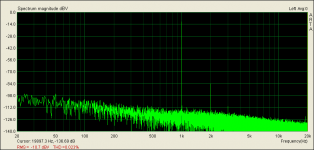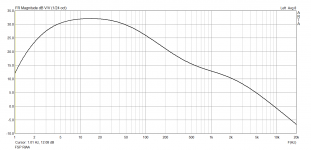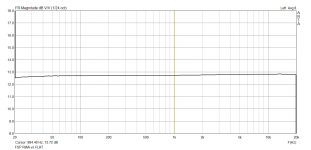Greg,
How would you define sound of Audyn Reference cap found on your pic
I ask because I had them In other serial application and they are at 100 hrs but sound very bright
How would you define sound of Audyn Reference cap found on your pic
I ask because I had them In other serial application and they are at 100 hrs but sound very bright
Audyn Reference cap
Hi samoloko, In that position in my system, quite a neutral presentation.
I thought the audyn copper was an improvement, despite the ad on HIFI
collective saying "Made for passive crossover network for loudspeakers only.
Any other useage is not allowed." 😕
Regards
Greg
Hi samoloko, In that position in my system, quite a neutral presentation.
I thought the audyn copper was an improvement, despite the ad on HIFI
collective saying "Made for passive crossover network for loudspeakers only.
Any other useage is not allowed." 😕
Regards
Greg
Thanks for the info on R6, your eyes are better than mine 😀
System as it stands:
Cart is a North west analogue low output MC with FGS tip.
The Pre is a 12 AU7,
12SN7 dual mono I put together some while ago.
TT is the ubiquitous 401 in a slate plinth with SME 12" (it's a modified 3009)
Tannoy 15" Gold in an Onken/Goodmans style cab. (excuse the gallon of paint 😀 )
KT88 PP Amp
And a couple of perhaps retired FSP's 😱
Thanks,
Greg
Greg, hi
Your cart uses excellent needle profile but is it 0.2mV output only? Is it based on a Denon motor?
Enough UFSP/FSP builds tend to 63dB LMC mode gain though.
What subjective differences you find between UFSP and FSP? Did you have other phono designs previously in the system, diy or ready made?
P.S. One of those FSPs has some expensive Z-Foil resistors which are easy to swap between builds if carefully desoldered.
Only handle them with tools by the "ears". If the flat part gets scratched it easily suffers a break in foil continuity and the resistor is written off.
Salas ultra FSP
Regards
Greg
Hi Salas,
"Your cart uses excellent needle profile but is it 0.2mV output only? Is it
based on a Denon motor?"
The cart uses only the "sledge" from the denon which holds the magnet.
Everything else, damper, cantilever, coils, tie wire are all hand made by Dom at
NWA. The output is only .2mV as you say, in practice you can, as you know
generate enough gain to make it viable . I'm fortunate that I have heard a large
number of high end MC's (Koetsu, Kiseki, SPU, Benz etc) and I like what the
DH3S does in comparison.
"What subjective differences you find between UFSP and FSP? Did you have
other phono designs previously in the system, diy or ready made?"
The original loses in sound stage (separation), fine detail, dynamics, and
timbrally (component choice?) and is a little (only a little ) noisier. It
sounded best to my ears using 40dB gain and a good step up.
The original has seen off all others I have and have owned/built. (I have
currently a good half dozen solid state phono's and three valve operated). I
only have one commercial product which is a modern Croft which is left in
the dust by both the FSP and UFSP.
The UFSP has not had enough hours on it yet and I'm still
playing with a couple of the C values. I expect it to get better 😀
As for the Z foils, I made several FSP's to try and quantify, back to back, just
what various components brought to the party. Whether it was my old ears
or a lack of fidelity in the rest of the system I don't know, but they certainly
weren't worth the expense 😱 . I might whip them out at a later date to
go in the UFSP. I wanted initially to get a feel for the kit as provided by
Teabag (which is, along with the guide a stunning piece of work).
"Your cart uses excellent needle profile but is it 0.2mV output only? Is it
based on a Denon motor?"
The cart uses only the "sledge" from the denon which holds the magnet.
Everything else, damper, cantilever, coils, tie wire are all hand made by Dom at
NWA. The output is only .2mV as you say, in practice you can, as you know
generate enough gain to make it viable . I'm fortunate that I have heard a large
number of high end MC's (Koetsu, Kiseki, SPU, Benz etc) and I like what the
DH3S does in comparison.
"What subjective differences you find between UFSP and FSP? Did you have
other phono designs previously in the system, diy or ready made?"
The original loses in sound stage (separation), fine detail, dynamics, and
timbrally (component choice?) and is a little (only a little ) noisier. It
sounded best to my ears using 40dB gain and a good step up.
The original has seen off all others I have and have owned/built. (I have
currently a good half dozen solid state phono's and three valve operated). I
only have one commercial product which is a modern Croft which is left in
the dust by both the FSP and UFSP.
The UFSP has not had enough hours on it yet and I'm still
playing with a couple of the C values. I expect it to get better 😀
As for the Z foils, I made several FSP's to try and quantify, back to back, just
what various components brought to the party. Whether it was my old ears
or a lack of fidelity in the rest of the system I don't know, but they certainly
weren't worth the expense 😱 . I might whip them out at a later date to
go in the UFSP. I wanted initially to get a feel for the kit as provided by
Teabag (which is, along with the guide a stunning piece of work).
Regards
Greg
Greg, thanks for your info and opinion. I am sure its interesting to all builders in this thread. 

Salas,thank you very much for so quick reply and clear info sharing.
One more question,if we parallel the Q1,That means use 2pcs of 2SK369 BL for the Q1,any performance improve? specially for the MC model of 62db gain.
does it can support 68db gain for the very low MC.
One more question,if we parallel the Q1,That means use 2pcs of 2SK369 BL for the Q1,any performance improve? specially for the MC model of 62db gain.
does it can support 68db gain for the very low MC.
When in LMC mode Q1 & Q2 run in parallel already via the DIP switches. It achieves 61-63dB gain in that mode depending on the components assorted match. Enough kit based builds show 63dB. You can't parallel more as it stands. You topple the current bias balance.
Measurements can vary a bit depending on C2Y choice and grounding success in each build. But practical noise problems with somewhat different construction and wiring choices haven't been reported yet from users. Especially for the UFSP guise builds.
Measurements can vary a bit depending on C2Y choice and grounding success in each build. But practical noise problems with somewhat different construction and wiring choices haven't been reported yet from users. Especially for the UFSP guise builds.
Greg,
thank you
which values did you combine using Audyn True Copper to get 2,2 uF
can you compare Audyn True Copper and Reference
thank you
which values did you combine using Audyn True Copper to get 2,2 uF
can you compare Audyn True Copper and Reference
Hi samoloko, In that position in my system, quite a neutral presentation.
I thought the audyn copper was an improvement, despite the ad on HIFI
collective saying "Made for passive crossover network for loudspeakers only.
Any other useage is not allowed." 😕
Regards
Greg
I have a question about adjusting the voltage on the phono testpoints to 4.008V. Everything seems to work but the voltage on TP is zero. What should be the switches setting when adjusting the voltage?
The gain mode of your choice should be set up with the switches before starting the T.P adjustment procedure.
P.S.
There is no need to be too precise. Just near 4V. Bit below preferable than bit above i.e. better 3.9V than 4.1V
P.S.
There is no need to be too precise. Just near 4V. Bit below preferable than bit above i.e. better 3.9V than 4.1V
Thanks a lot to Salas and Tea for this build! My record collection is now shining as never before.
I have installed it preliminary in an old case, but this build deserves a new case.
some pic's:
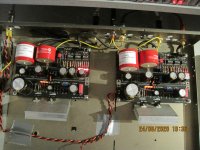
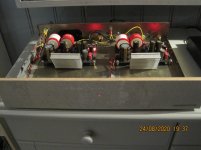
The front panel has a concrete look. Same as my bathroom😀
My TT, cart and arm🙂
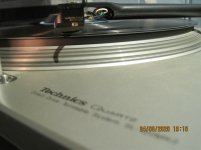
Had some hum problem on left channel on my RB300 arm. Had to modify the grounding of the arm with a separate ground wire. Now everything is silent.
Tried to make an arta measurement with a RIAA FR correction.
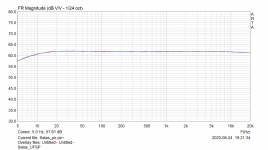
almost 62dB Gain and channels seems quite close thanks to Tea's close matching.
best,
Paal
I have installed it preliminary in an old case, but this build deserves a new case.
some pic's:


The front panel has a concrete look. Same as my bathroom😀
My TT, cart and arm🙂

Had some hum problem on left channel on my RB300 arm. Had to modify the grounding of the arm with a separate ground wire. Now everything is silent.
Tried to make an arta measurement with a RIAA FR correction.

almost 62dB Gain and channels seems quite close thanks to Tea's close matching.
best,
Paal
Nice. Excellent match. Congratulations.
You could use the chassis floor instead of sinks in the new case. Is your Anti-Riaa 3.18uS "lost constant" type, thus the mild FR drop in last octave?
Or just 20Hz-20kHz numbers coming from a paper like TI's AN-346 app note?
You could use the chassis floor instead of sinks in the new case. Is your Anti-Riaa 3.18uS "lost constant" type, thus the mild FR drop in last octave?
Or just 20Hz-20kHz numbers coming from a paper like TI's AN-346 app note?
Depends on the audio card too. Those numbers are elaborate, can't directly compare them to my numbers (fewer different spot frequencies derived from math) but they look near and they should be adequate. Try mine to see. What load resistor & C2Y you use with the AT-OC10?
# RIAA Standard Response Normalized to 1 KHz
# Edited by Salas produced from time constants
#
20, 19.36
28, 18.83
40, 17.88
50, 17.03
63, 15.94
80, 14.59
100, 13.18
160, 9.90
200, 8.31
315, 5.27
400, 3.87
500, 2.74
800, 0.84
1000, 0.09
1500, -1.31
2000, -2.50
3000, -4.65
4000, -6.52
5000, -8.12
6100, -9.64
8000, -11.81
10000, -13.65
15000, -17.07
20000, -19.53
# RIAA Standard Response Normalized to 1 KHz
# Edited by Salas produced from time constants
#
20, 19.36
28, 18.83
40, 17.88
50, 17.03
63, 15.94
80, 14.59
100, 13.18
160, 9.90
200, 8.31
315, 5.27
400, 3.87
500, 2.74
800, 0.84
1000, 0.09
1500, -1.31
2000, -2.50
3000, -4.65
4000, -6.52
5000, -8.12
6100, -9.64
8000, -11.81
10000, -13.65
15000, -17.07
20000, -19.53
Hehe, sharp eyes🙂 I bought the cart about 25 years ago (AT 30'th aniversary model. only used a few hours.)
I guess a new cart could do. I will try not to end up broke😉
Load resistor is 220R and C2=14,91 C2Y=220 at the moment. I will try other values later. Do you have any proposed values in mind?
I guess a new cart could do. I will try not to end up broke😉
Load resistor is 220R and C2=14,91 C2Y=220 at the moment. I will try other values later. Do you have any proposed values in mind?
- Home
- Source & Line
- Analogue Source
- Simplistic NJFET RIAA
